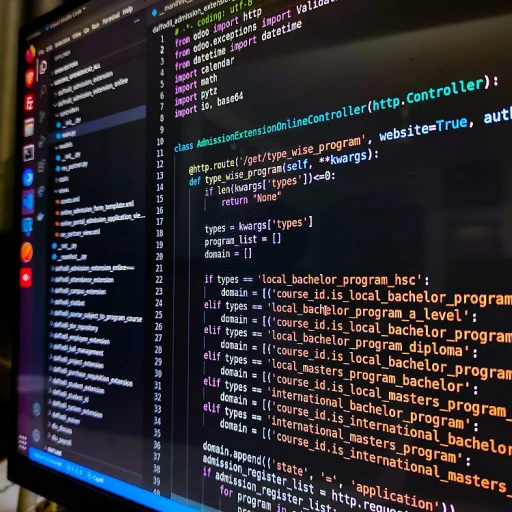Understanding the Need for Security-First Development
The Growing Importance of Security in Software Development
As we delve into today's software development practices, it's undeniable that security has taken center stage. With a surge in cyber threats and data breaches, the significance of secure development is more pronounced than ever. Developers are no longer just coding for functionality – safeguarding sensitive data and minimizing risk has become a core part of their responsibilities.
Why the sudden shift? Well, it boils down to the evolving threat landscape where hackers are becoming more sophisticated. Traditional methods are proving insufficient against modern challenges, pushing organizations to embed security measures across all stages of the development process. This cultural shift, often dubbed "shift left," encourages an early emphasis on application security in the development lifecycle rather than an afterthought.
With dev teams working collectively with security experts, it's a collaborative effort to foresee potential threats and design secure applications right from the get-go. Not only does this approach minimize risk, but it also builds a robust security posture, giving organizations and customers peace of mind. As discussed in cybersecurity developments, it’s a continuous process requiring constant vigilance and adaptation.
Key Principles of Security-First Software Design
Building a Security Culture from the Ground Up
Creating a security-first mindset in software development isn't just about slapping on a few extra steps in the process. It's about embedding security into the very DNA of your development culture. Think of it as teaching a child to look both ways before crossing the street; it's not just a rule, it's a habit. Organizations need to foster an environment where developers are encouraged to think about security at every stage of the development lifecycle.
Developers should be trained to write secure code and understand the risks associated with their work. This means regular security training sessions, workshops, and even hackathons that focus on security challenges. When developers see security as a shared responsibility, it becomes a natural part of their workflow, not an afterthought.
Embracing Security Design Principles
Security design principles are the bedrock of secure software. They guide developers in making choices that protect sensitive data and reduce vulnerabilities. Here are some principles that should be part of every developer's toolkit:
- Least Privilege: Limit user access rights to the bare minimum needed to perform their job.
- Defense in Depth: Use multiple layers of security controls to protect data and applications.
- Fail Securely: Ensure that when systems fail, they do so in a secure manner.
- Keep It Simple: Complex systems are harder to secure. Simplicity can reduce the risk of errors.
By incorporating these principles, developers can create applications that are resilient against threats and secure from the ground up.
Security Testing: The Unsung Hero
Testing is where the rubber meets the road in security. It's not enough to design a secure application; you have to test it rigorously to uncover potential vulnerabilities. This involves a mix of automated tools and manual testing techniques.
Automated tools can quickly scan code for known vulnerabilities, while manual testing, such as penetration testing, can identify issues that automated tools might miss. Both are essential in maintaining a strong security posture. For more insights on the evolution of software security, check out this article.
Threat Modeling: Anticipating the Enemy
Threat modeling is about predicting potential threats and designing your application to withstand them. It's a proactive approach that helps developers understand the types of attacks their software might face and how to mitigate them. By thinking like an attacker, developers can identify weak points and strengthen them before they become a problem.
Incorporating threat modeling into your development process not only improves security but also helps developers understand the importance of secure coding practices. It's about building a mindset where security is considered at every step, from design to deployment.
Building a Secure Foundation with the Right Tools
Incorporating the right mix of tools and technologies can make all the difference when it comes to secure software development. As developers face increasingly sophisticated threats, choosing the right tools can ensure they build applications that not only meet functional requirements but also stand strong against potential security breaches.
First up, code analysis tools are your trusty sidekicks. These tools scan the codebase to uncover vulnerabilities early in the development lifecycle. Static Application Security Testing (SAST) tools, such as Checkmarx and Fortify, analyze source code and can catch vulnerabilities that might be hiding beneath the surface. They provide developers immediate feedback, allowing them to fix issues long before they snowball into larger problems. Incorporating these tools aligns perfectly with the "shift left" mentality, advocating for early issue detection.
Then there's Dynamic Application Security Testing (DAST), adding another layer of security by evaluating running applications. Using tools like OWASP ZAP or Burp Suite lets developers identify vulnerabilities in real-time. DAST tools are particularly valuable because they can simulate attacks on live applications to see how they hold up under pressure.
Of course, the move to DevSecOps has brought security into the heart of development teams. This cultural shift prioritizes security throughout the development process, ensuring that security concerns are addressed continuously rather than as an afterthought. With integrations into CI/CD pipelines using tools like Jenkins or GitLab CI, security becomes everyone's responsibility.
Open source tools are also playing a significant role in the security toolkit. Tools like SonarQube provide insights into code quality and security, helping developers maintain a healthy codebase without breaking the bank. They appeal to a broad range of developers and organizations looking for cost-effective solutions that don't skimp on security measures.
Lastly, let’s not forget about incident response tools. They are essential for effective management when things don't go as planned. Incorporating tools like Splunk and Rapid7, which help gather and analyze security data, ensures that organizations can swiftly respond to threats and minimize risk to sensitive data.
With the right tools in place, developers can strengthen their application security and build robust software that the organization can trust. For a deeper dive into modern development methodologies, including tools that elevate the developer experience, check out this
exploration of the best headless CMS options for modern development.
Sources:
- Checkmarx (https://www.checkmarx.com/)
- OWASP (https://owasp.org/www-project-zap/)
Challenges in Implementing Security-First Practices
Security Challenges in Software Development
Developers face various hurdles when bringing a security-first mindset to software development. It's not just about writing secure code, but weaving security into every layer of the design.
One of the most significant obstacles is balancing tight deadlines with thorough security testing. Fast-paced releases often prioritize functionality over security, causing developers to cut corners. Ensuring that robust security measures are implemented requires an organization's unwavering commitment and clear processes.
Budget constraints can also be a factor. Organizations may balk at allocating resources for security unless they experience a direct risk or data breach themselves. Unfortunately, waiting for an incident can lead to far more costly consequences when sensitive data is compromised.
Another hurdle is the jargon-heavy nature of security terminology. Developers might struggle with understanding security guidelines if they're filled with overly complex terms. Streamlining communication and providing structured training can make a difference in foster a solid security culture.
Also, while open source tools offer ample resources for developers, they carry risks. The transparency of open source code can leave an organization vulnerable to new threats if vulnerabilities are not constantly monitored and patched.
Security measures should be consistent throughout the software's development lifecycle. This involves incorporating security design in every phase of application development, from risk assessment to agile iterations and security testing.
It's not just the developer's responsibility, but an organizational approach to ensure developer security practices are followed. Management must foster a culture that prioritizes data security and supports developers with the right tools and training. A successful security posture involves everyone being attuned to the changing threats, with regular updates to approach and response strategies.
Organizations committed to developer security not only survive but thrive amid emerging threats. By addressing these challenges head-on, they can innovate while maintaining the integrity and trust that secure applications command.
The Role of Continuous Learning and Training
The Human Element: Continuous Learning and Training in Secure Development
Developers aren't born experts in security. It's an ongoing journey, a commitment to learning and adapting as new threats and challenges arise. For organizations aiming to bolster their security measures, fostering a culture of continuous learning is non-negotiable. But how does this play out in the real world of coding and development?
Gone are the days when static security manuals collected dust. Today, the heartbeat of an effective security culture is dynamic training programs. Organizations are implementing regular workshops and sessions, focusing on both current vulnerabilities and speculative future threats that could impact application security. This approach keeps developers well-equipped to anticipate and tackle security challenges head-on.
There's also the behavioral aspect. Imagine a developer who attends regular training sessions—these aren't just routine meetings, but opportunities to explore new security practices and unwind intricate code problems. They become adept at spotting vulnerabilities during the development process itself, thus integrating security more naturally into their workflow.
The Balance of Tools and Human Expertise
Technology and training need to dance together. While numerous tools can aid security testing and secure coding, they are best wielded by knowledgeable hands. Automated tools might catch certain flaws, but it's the insightful developer who interprets these alerts critically, applying judgment and experience.
Consider the role of threat modeling workshops, where developers simulate potential attacks on their code. This practice not only sharpens technical skills but deeply entrenches an understanding of the risks that could compromise sensitive data. Developers share insights, elevating the team's ability to respond to incidents and reinforcing their security-first approach.
Building a robust security posture also involves staying informed about the broader software security environment. Open-source projects such as OWASP provide a wealth of resources and forums for sharing community-driven insights on secure design and developer security. Engaging with these can imbue developers with a sense of belonging to a larger movement, encouraging them to adopt industry best practices.
The Organizational Commitment
Sustaining a secure coding culture isn't something developers can shoulder alone. Organizational support is fundamental. From investing in ongoing threat modeling exercises to subscribing to cutting-edge security management tools, the backing of the company underscores the importance of secure software as an organizational principle.
Moreover, fostering collaborations between different teams can further bolster security awareness. When developers, testers, and management communicate openly about potential threats and secure design principles, it cultivates a security-focused environment.
Ultimately, merging continuous learning with everyday development practices ensures that security is not an afterthought. It becomes intrinsic to the way developers think, design, and code. For in-depth insights on how software trends are shaping cybersecurity, consider visiting
emerging software trends in cybersecurity, which can offer additional perspectives on keeping your organization safe in an ever-evolving environment.
Future Trends in Security-First Software Development
Innovation in Security-Rich Software Development
In the fast-paced realm of software creation, security is increasingly being acknowledged as a non-negotiable aspect of development. The future shines bright, with trends pointing towards a more robust integration of security-first approaches, aligning with comprehensive development principles. This transition means more than just embedding security functions or sporadic checks; it's about weaving a security mindset throughout the software development lifecycle.
Security tests and threat modeling are now receiving attention from the get-go. The industry buzzword "shift left" underscores this movement, stressing the importance of addressing potential risks earlier in the process. Developers can catch vulnerabilities at a nascent stage, saving time, resources, and safeguarding sensitive data. By reinforcing a security culture from the start, companies see reduced threats and a stronger security posture.
Technologies like AI and machine learning (ML) are starting to lend a hand. These advanced tools help predict risks and automate security measures, ensuring secure coding and thorough application security testing. For developers, this means more effective coding practices, as they can rely on AI-driven insights to guide secure design choices throughout their work.
Open source software is another area seeing growth. While it presents its own set of challenges due to public accessibility, guided use backed by community monitoring and security patches can turn it into a boon for applications, facilitating shared knowledge and rapid solutions to emerging threats. Organizations that prioritize continuous learning and training for developer security can navigate these waters with greater confidence and precision.
A well-rounded approach to evolving software security includes incident response planning as a critical element of the development process. By preparing for potential breaches or issues, developers put themselves in a better position to respond swiftly and effectively, minimizing damage and ensuring a more resilient application environment.
By keeping an eye on evolving security threats, embracing cutting-edge tools, and fostering an all-encompassing security culture, companies are better equipped to handle the challenges of today and tomorrow. As organizations lay down these new-age security practices, they open up a path toward more reliable and secure software development outcomes.
Stay tuned to discover how the intersection of technology advances and security practices continue to redefine the future. To learn more about this intersection, you might find this discussion on
emerging software trends relevant and insightful.
By embracing these trends, developers and organizations can move forward with confidence, creating secure, high-quality software.















